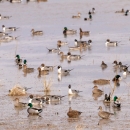About Us
Meredosia National Wildlife Refuge is 3,645 acres and is located in an area that was historically known for its ability to sustain fish and wildlife along the east side of the Illinois River in Morgan and Cass counties, near the town of Meredosia, Illinois. The refuge is part of the traditional homeland of the Illinois people, past and present. Today, the Illinois people are recognized as the Peoria Tribe of Indians of Oklahoma, a confederation of Kaskaskia, Peoria, Piankeshaw and Wea tribes of Illinois and Indiana. They are descendants of those who created the great mound civilizations in the central Unites States. Subsequent tribes that also lived here were the Kickapoo and Potawatomi. We honor with gratitude their past and present as we continue stewardship of these lands, waters, fish and wildlife. The refuge is broken into several management units, each with varying habitat types.
Management Units
The Island
Meredosia Island Unit is the largest management unit at 2,350 acres in size and is a mosaic of habitat types with seasonal wetlands, bottomland forest and scrub-shrub habitat. The best way to enjoy the island is by boat on Meredosia Lake, accessible from Beach Road. Boat ramp access is also available at the Grierson Prairie Unit.
Evan’s Prairie
Prairies are another important piece in the refuge landscape. Evan’s Prairie is a 135-acre unit in the southern portion of the refuge. Although dominated by bottomland forest, the east side of the unit has a 30-acre prairie, part of which is a rare remnant sand prairie. Evan’s Prairie is accessible to the public with information kiosks and a trail to an observation deck located at 2227 Beach Road in Meredosia, Illinois.
Shearl-Skinner
The Shearl-Skinner Units have an access point off Toe Head Road. A lane through a small sand prairie leads to a parking area with and informational kiosk. From the parking area, 550 acres of seasonally managed wetland are accessible by foot along service roads and levee tops.
Willow Creek-Lake Unit
Situated between Evan’s Prairie and the Shearl-Skinner Unit, the 250-acre Willow Creek-Lake Unit is located in the southern portion of the refuge. About half of the unit, 125 acres, is open water of an oxbow lake. Most of the remaining unit is bottomland forest.
Grierson Prairie
Grierson Prairie is a 180-acre unit in the eastern portion of the refuge with a boat ramp access to the adjacent Meredosia Lake, near the intersection of Beach Road and Morgan-Cass County Line Road. On the western side of the levee is a narrow strip of bottomland forest adjacent to the lake. East of the levee, the unit is managed for moist soil and wet prairie.
Kloker
Northeast of Grierson is the Kloker Unit is a 275 acre upland forest unit located along the bluff of the Illinois River. There, forests still stand as they did in the late 1800s. This area provides an important buffer for migratory birds from the adjacent agricultural fields.
Meredosia National Wildlife Refuge is managed as part of the Illinois River National Wildlife and Fish Refuge Complex. This complex stretches along 124 miles of the Illinois River in west central Illinois and consists of three refuges: Emiquon National Wildlife Refuge, Chautauqua National Wildlife Refuge and Meredosia National Wildlife Refuge. The complex totals 13,000 acres of backwater lakes, bottomland forests, floodplain wetlands and upland habitats.
Our Mission
The mission of the National Wildlife Refuge System is to administer a national network of lands and waters for the conservation, management and, where appropriate, restoration of the fish, wildlife and plant resources and their habitats within the United States for the benefit of present and future generations of Americans.
Every national wildlife refuge national wildlife refuge
A national wildlife refuge is typically a contiguous area of land and water managed by the U.S. Fish and Wildlife Service for the conservation and, where appropriate, restoration of fish, wildlife and plant resources and their habitats for the benefit of present and future generations of Americans.
Learn more about national wildlife refuge was created for a special purpose. Some were created to protect migratory birds, others to protect threatened or endangered species or unique habitats, while others fulfill another special purpose. All activities allowed on refuges must be evaluated to make sure each activity will not conflict with the reason the refuge was founded.
The refuge was established to provide an inviolate sanctuary for wildlife, primarily for waterfowl and other migratory birds. Land management programs are designed and administered to promote migratory bird, fish and resident wildlife habitat in the Illinois River basin, while providing for public recreation opportunities.
Our History
September 1922 - First Illinois chorus frog specimen is collected on what would later become the refuge.
May 9, 1973 - Meredosia National Wildlife Refuge is established through a land donation by Mr. James Anderson and partnership with The Nature Conservancy.
Other Facilities in this Complex
Meredosia National Wildlife Refuge is managed as part of the Illinois River National Wildlife and Fish Refuge Complex. This complex stretches along 124 miles of the Illinois River in west central Illinois, and consists of three refuges: Emiquon National Wildlife Refuge, Chautauqua National Wildlife Refuge and Meredosia National Wildlife Refuge. The complex totals 13,000 acres of backwater lakes, bottomland forests, floodplain wetlands and upland habitats.



